How To Calculate Margin In Forex
Margin Adding for Retail Forex, Futures
The trading platform provides different risk management models, which define the type of pre-trade control. The following models are currently available:
- For Retail Forex, Futures — used for the OTC market place. Margin adding is based on the blazon of instrument.
- For Stock Commutation, based on margin discount rates — used for the commutation market. Margin adding is based on the discounts for instruments. Discounts are set by the broker, yet they cannot be lower than the exchange fix values.
The margin is charged for securing traders' open positions and orders.
The start stage of the margin calculation is defining if an account has positions or pending orders for the symbol, for which a merchandise is performed.
- If the account has no positions and orders for the symbol, the margin is calculated using the formulas below.
- If the account has an open position, and an club of whatsoever type with the volume being less or equal to the current position is placed in the opposite direction, the total margin is equal to the current position's one. Example: we take a 1 lot EURUSD Buy position and place an order to Sell 1 lot EURUSD (similarly for Sell Limit, Sell Stop and Sell Finish Limit).
- If the account has an open position, and an gild of any type is placed in the aforementioned direction, the total margin is equal to the sum of the current position'due south and placed order'south margins.
- If the account has an open position, and an order of any type with the book exceeding the current position is placed in the opposite direction, ii margin values are calculated - for the electric current position and for the placed order. The final margin is taken according to the highest of the 2 calculated values.
- If the account has ii or more oppositely directed market and limit orders, the margin is calculated for each direction (Purchase and Sell). The final margin is taken according to the highest of the two calculated values. For all other order types (Terminate and End Limit), the margin is summed up (charged for each guild).
Below are the symbol margin calculation formulas co-ordinate to their type and settings. The final margin is calculated in three stages:
- Basic adding for a certain symbol;
- Conversion of the margin currency into the deposit one
- Multiplication by gene
- Considering trading symbols that are in spread
- Accounting multiple positions/orders of the same symbol
Basic Calculation for a Symbol #
If "Initial margin" parameter value is prepare in the symbol specification, this value is used. The formulas described in this department are non applied.
The trading platform provides several margin requirement calculation types depending on the financial musical instrument. Calculation blazon is displayed in the "Calculation" field of the symbol specification:
Forex
The margin for the Forex instruments is calculated by the following formula:
Volume in lots * Contract size / Leverage
For instance, permit's calculate the margin requirements for ownership i lot of EURUSD, while the size of one contract is 100,000 and the leverage is 1:100.
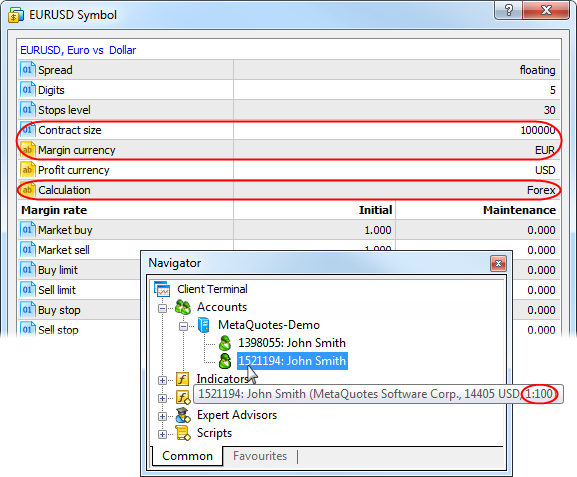
Later placing the advisable values to the equation, we volition obtain the following consequence:
one * 100 000 / 100 = 1 000 EUR
Then, now we take the margin requirements value in base of operations currency (or margin currency) of the symbol.
- Generally, margin requirements currency and symbol's base currency are the same. If the margin currency is unlike, adding results are displayed in that currency instead of the symbol's base of operations one.
- In this way, a trader leverage is taken into account fifty-fifty if a fixed margin is set.
Forex No Leverage #
This type of calculation is also used for Forex symbols. But unlike the previous one, it does not take into account the trader'south leverage:
Volume in lots * Contract size
For instance, let's calculate the margin requirements for buying ane lot of EURUSD, while the size of one contract is 100 000 and the leverage is i:100. Afterwards placing the appropriate values to the equation, we will obtain the post-obit effect:
1 * 100000 = 100000 EUR
And then, now we have the margin requirements value in base currency (or margin currency) of the symbol.
Generally, margin requirements currency and symbol's base currency are the same. If the margin currency is unlike, calculation results are displayed in that currency instead of the symbol's base one.
Contracts, Exchange Stocks
The margin requirements for contracts and stocks are calculated using the following equation:
Book in lots * Contract size * Open up market price
The electric current market Ask toll is used for buy deals, while the electric current Bid price is used for sell ones.
For case, let's calculate the margin requirements for buying one lot of #AA, the size of the contract is 100 units, the electric current Ask price is 33.00 USD.
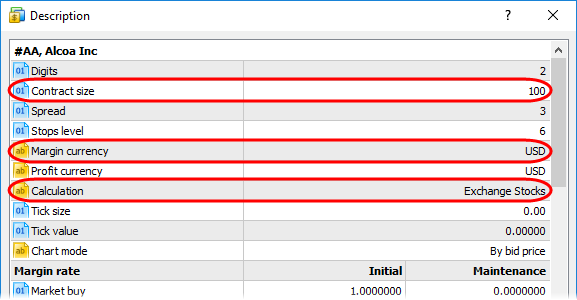
Later on placing the appropriate values to the equation, we volition obtain the post-obit result:
i * 100 * 33.00 = 3300 USD
So, now we have the margin value in base currency (or margin currency) of the symbol.
Contracts Leverage
The leverage is likewise considered in this type of margin requirement calculation for contracts:
Volume in lots * Contract size * Open up market cost / Leverage
Contracts Alphabetize #
For index contracts, the margin requirements are calculated co-ordinate to the following equation:
Book in lots * Contract size * Open up market price * Tick price / Tick size
In this formula, the ratio of price and tick size is considered in addition to common contracts calculation.
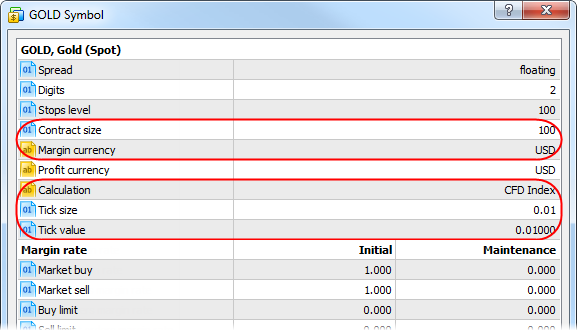
Futures, Exchange Futures #
There are two types of the margin requirements for futures contracts:
- Initial margin is the amount that must be available on the account at the moment of attempting to enter the market. Further maintenance of the same sum may non exist obligatory.
- Maintenance margin is the minimum amount that must be bachelor on the account for maintaining an open position.
Both values are specified in the symbol specification.
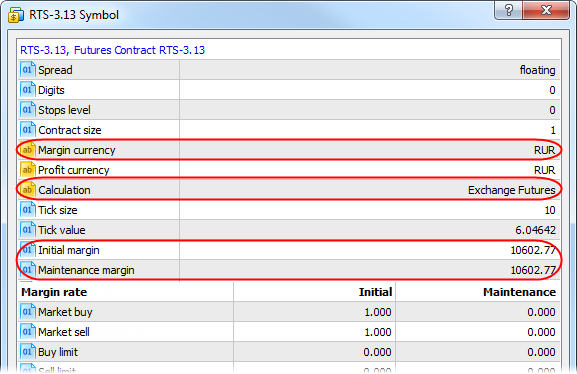
The final size of the margin depends on the volume:
Volume in lots * Initial margin
Volume in lots * Maintenance margin
If the amount of the maintenance margin is not specified, the initial margin value is used instead.
Commutation Options #
At that place are two types of margin requirements for futures contracts:
- Initial margin is the corporeality that must be available on the account at the moment of attempting to enter the marketplace. Further maintenance of the same corporeality may not be obligatory.
- Maintenance margin is the minimum amount that must be available on the account for holding a position open.
Both values are specified in the symbol specification. The final size of the margin depends on the volume:
Volume in lots * Initial margin
Book in lots * Maintenance margin
If the corporeality of the maintenance margin is not specified, the initial margin value will be used instead. If neither the initial nor the maintenance margin is specified, the advisable value will be calculated according to the post-obit formula:
Book in lots * Contract size * Open market place cost
The current market Ask price is used for buy deals, while the current Bid price is used for sell deals.
The aforementioned calculation method is applied for all take a chance management modes.
Exchange Bonds #
The bond margin is calculated as part of the position value. Bond prices are provided every bit a face up value per centum, then the position value is calculated as follows:
Volume in lots * Contract size * Face value * Price / 100
The part of the position value to exist reserved for maintenance is determined by margin ratios.
FORTS Futures
The margin for the futures contracts of the Moscow Exchange derivative section is calculated separately for each symbol: First, the margin is calculated for the open position and all Buy orders. So the margin for the same position and all Sell orders is calculated.
MarginBuy = MarginPos + Sum(MarginBuyOrder)
MarginSell = MarginPos + Sum(MarginSellOrder))
The largest one of the calculated values is used every bit the final margin value for the symbol.
Thus, the same position is used in the calculation of both values. In the starting time formula (which includes Purchase orders), the position margin is calculated as follows:
MarginPos = Book * (InitialMarginBuy + (Open up Price - SettlementPrice) * Tick Cost / Tick Size * (1 + 0.01 * Margin Currency Rate))
The volume is used with a positive sign for long positions and with a negative sign for brusk positions.
In the second formula (which includes Sell orders), the position margin is calculated equally follows:
MarginPos = Volume * (InitialMarginSell + (SettlementPrice - Open Price) * Tick Price / Tick Size * (1 + 0.01 * Margin Currency Rate))
The volume is used with a positive sign for short positions and with a negative sign for long positions.
This approach provides the trader a disbelieve on margin, when there is an open up position in the opposite direction with respect to the orders placed (the position acts as collateral for orders).
Margin on orders is calculated past the following formulas:
MarginBuyOrder = Volume * (InitialMarginBuy + (Price - SettlementPrice) * Tick price / Tick size * (ane + 0.01 * Margin currency charge per unit))
MarginSellOrder = Book * (InitialMarginSell + (SettlementPrice - Price) * Tick price / Tick size * (1 + 0.01 * Margin currency rate))
'Toll' here depends on the guild fourth dimension and can be equal to:
- The Highest and the Everyman price of the contract for the current session is used for not yet executed market or stop Buy and Sell orders, respectively. Since the cost is not specified in market orders, the trader is charged the maximum possible margin. In one case triggered, cease orders behave similar to marketplace orders .
- The lodge price is used for limit orders.
- The End Limit price is used for terminate limit orders.
Other parameters in the formulas:
- InitialMarginBuy — the initial margin for the Buy functioning.
- InitialMarginSell — the initial margin for the Sell functioning.
- Currency margin rate is the rate change radius of the currency, a futures contract is denominated in, relative to the Russian ruble
- SettlementPrice — settlement toll of an instrument for the current session.
All these parameters for calculation are provided past the Moscow Exchange.
InitialMarginBuy is written to the "Initial margin" field, InitialMarginSell is written to the "Maintenance Margin" field in symbol properties.
Calculation example
The below example shows the calculation of margin requirements for the following trading account state:
- Position Buy 3.00 Si-vi.18 at 73640
- Social club Purchase Limit 2.00 Si-six.eighteen at 73000
- Order Sell Limit ten.00 Si-six.18 at 74500
Current session parameters
- Clearing cost = 73638
- InitialMarginBuy = 7665.41
- InitialMarginSell = 7739.59
- Tick toll = 1
- Tick size = one
- Margin currency rate = 0
Nosotros substitute the values in the formulas
MarginBuy = 3 * (7665.41 + (73640 - 73638) * i/one) + 2 * (7665.41 + (73000-73638) * 1/i) = 37057.05
MarginSell = -three * (7739.59 + (73638-73640) * 1/1) +ten.0 * (7739.59 + (73638-74500) * 1/1) = 45563.13
Margin = Max(37057.05, 45563.13) = 45563.thirteen
The resulting margin for the Si-6.xviii symbol is 45563.13.
Collateral #
Non-tradable instruments of this type are used as trader's avails to provide the required margin for open positions of other instruments. For these instruments the margin is not calculated.
Fixed Margin #
If the "Initial margin" field of the symbol specification contains whatever non-naught value, the margin calculation formulas specified in a higher place are not applied (except for the calculation of futures, as everything remains the same there). In this instance, for all types of calculations (except for Forex and Contracts Leverage), the margin is calculated similar for the "Futures" calculation type:
Volume in lots * Initial margin
Volume in lots * Maintenance margin
Calculations of the Forex and Contracts Leverage types additionally permit for leverage:
Volume in lots * Initial margin / Leverage
Book in lots * Maintenance margin / Leverage
If the corporeality of the maintenance margin is not specified, the initial margin value is used instead.
Converting into Deposit Currency #
This stage is mutual for all calculation types. Conversion of the margin requirements calculated using one of the to a higher place-mentioned methods is performed in instance their currency is different from the account eolith 1.
The current exchange charge per unit of a margin currency to a deposit one is used for conversion. The Ask price is used for buy deals, and the Bid price is used for sell deals.
For example, the basic size of the margin previously calculated for buying one lot of EURUSD is 1000 EUR. If the account deposit currency is USD, the current Ask price of EURUSD pair is used for conversion. For example, if the current charge per unit is i.2790, the total margin size is 1279 USD.
Margin Charge per unit #
The symbol specification allows setting additional multipliers (rates) for the margin requirements depending on the position/order type.
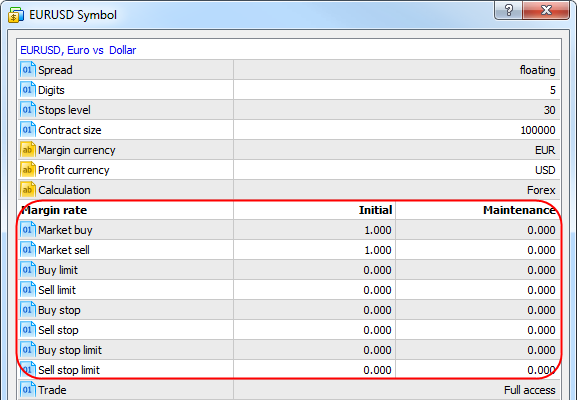
The final margin requirements value calculated taking into business relationship the conversion into the eolith currency, is additionally multiplied by the appropriate rate.
For example, the previously calculated margin for buying i lot of EURUSD is 1279 USD. This sum is additionally multiplied by the long margin rate. For example, if it is equal to 1.xv, the terminal margin is 1279 * 1.fifteen = 1470.85 USD.
Calculations for Spread Trading #
The margin tin be charged on preferential basis in case trading positions are in spread relative to each other. The spread trading is divers as the presence of the oppositely directed positions of correlated symbols. Reduced margin requirements provide more trading opportunities for traders. Configuration of spreads is described in a separate section.
Spreads are only used in the netting system for position accounting.
Calculation in the hedging system of position accounting #
If the hedging position accounting system is used, the margin is calculated using the same formulas and principles every bit described in a higher place. All the same, there are some additional features for multiple positions of the same symbol.
Positions/orders open in the same direction
Their volumes are summed up and the weighted average open price is calculated for them. The resulting values are used for calculating margin by the formula corresponding to the symbol type.
For pending orders (if the margin ratio is non-nil) margin is calculated separately.
Opposite Positions/Orders
Oppositely directed open positions of the same symbol are considered hedged or covered. Ii margin calculation methods are possible for such positions. The calculation method is adamant past the banker.
| Bones calculation | Using the larger leg |
|---|---|
| Used if "calculate using larger leg" is not specified in the "Hedged margin" field of contract specification. The calculation consists of several steps:
The resulting margin value is calculated as the sum of margins calculated at each pace. Calculation for uncovered volume
Adding for covered book Used if the "Hedged margin" value is specified in a contract specification. In this case margin is charged for hedged, as well as uncovered volume. If the initial margin is specified for a symbol, the hedged margin is specified equally an accented value (in budgetary terms). If the initial margin is not specified (equal to 0), the contract size is specified in the "Hedged" field. The margin is calculated by the appropriate formula in accordance with the type of the financial instrument, using the specified contract size. For example, we have two positions Buy EURUSD 1 lot and Sell EURUSD one lot, the contract size is 100,000. If the value of 100,000 is specified in the "Hedged field", the margin for the two positions will be calculated every bit per 1 lot. If you lot specify 0, no margin is charged for the hedged (covered) volume. Per each hedged lot of a position, the margin is charged in accordance with the value specified in the "Hedged Margin" field in the contract specification:
Calculation for awaiting orders
Calculation specifics for hedging orders when using fixed margin When an lodge reverse to an existing position is placed, the margin on the hedged book is always calculated using the "Hedge margin" value. For the non-hedged volume, the "Initial margin" value is used when placing an club, and "Maintenance margin" is applied after the appropriate position is opened. These calculation specifics only apply for symbols, for which the initial and maintenance margin values are specified (calculation blazon "Fixed margin" or "Futures"). For example, the post-obit parameters are used for EURUSD:
A trader has a position Buy 1.00 BR-12.18 on a USD account. A margin of 500 USD (equally per the "Maintenance margin") is reserved on the trader'south business relationship for this position.
| Used if "calculate using larger leg" is specified in the "Hedged margin" field of contract specification.
|
| Example The following positions are present:
Hedged margin size = 100 000. Buy margin rate = 2, for Sell = 4. Calculate hedged book: Sell volume (3) - Buy volume (2) = 1 Calculate the weighted average Open price for the hedged volume by all positions: (one.11943 * 1+1.11953 * one+one.11943 * 1+1.11953 * 1+1.11943 * 1)/5 = v.59735/5= 1.11947 Calculate the weighted average Open up cost for the not-hedged book by all positions: (ane.11943 * one + 1.11943 * one + one.11943 * 1)/3 = 1.11943 Calculate the margin ratio for the hedged volume: (purchase ratio + sell ratio)/two = (two + iv)/two = three The larger leg (sell) margin ratio is used for the not-hedged volume: iv. Summate the hedged volume margin using the equation: (2.00 lots * 100000 EUR * 1.11947 * 3) / 500 = 1343.36 Summate the not-hedged volume margin using the equation: (one.00 lot * 100000 EUR * 1.11943 * 4) / 500 = 895.54 The final margin size: 1343.364 + 895.544 = 2238.90 |
Source: https://www.metatrader5.com/en/terminal/help/trading_advanced/margin_forex
Posted by: ybarracopievere.blogspot.com


0 Response to "How To Calculate Margin In Forex"
Post a Comment